Cleaning up our Act
Science Nugget: October 1, 1999
This week we go "behind the scenes" at SXT data reduction central.
Follow along as we reveal some of the secrets of the SXT team.
Introduction
The Yohkoh project has tried very hard to reach out to the public
with X-ray images of the solar corona. The most recent
SXT image is always available at the
SXT First Light
web page, a similar mirror (identical) site in
Japan,
and at various other locations on the web. Literally tens of thousands of
posters of the X-ray sun have been distributed world-wide. The level of
public awareness of the sun is measureably higher than it was in the
pre-Yohkoh days.
The images that people are familiar with, though, have been cleaned up
quite dramatically from the raw data. Lots of instrumental artifacts with
strange names -- CCD bleed, dark current, stray light, to name a few --
are removed before the interested
viewer gets to see to the final image. This nugget, hence, attempts to
describe, in layman's terms, the long twisty maze that SXT data
travels through before it reaches your screen.
The Raw Materials
A 'basic' SXT full-frame, movie-quality
image
passes through a number of steps before it shows up at your door.
Why? Well, let's have a look at the raw data:
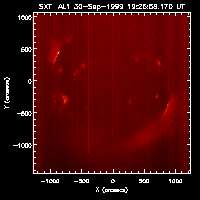
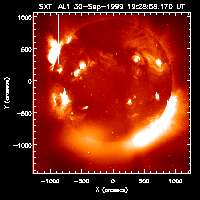
Whoa! Those are some lousy images! The one on the left (short
exposure) has no detail to amount to much. It is only useful in
those parts of the image where it is really bright.
The one on the right (long exposure) has some sort of fog growing in the
bottom, and a big spiky hairdo on the top left. This image is useful
only in those parts of the image where it is relatively faint.
Where the image is really bright the CCD is overexposed, which
causes "bleeding" -- spilling of the signal into adjacent picture
elements, or pixels -- into vertical streaks (spikes).
How is it possible for
this sort of nonsense to be turned into a beautiful SXT
image?
Well...it ain't easy.
The Method to our Madness
There are numerous things that have to happen to these 'diamond in the
rough' images before they're suitable for public (and scientific!)
consumption. An approximate version of the process follows:
- The raw data are decompressed.
The digital data aboard the spacecraft
are subjected to a simple compression algorithm before being
downloaded to the ground. Such compression reduces the number of computer
bits used to represent the image, and hence allows more images to be
transmitted within the limited daily downlink capacity.
(The compression algorithm is simple, but
beyond the scope of the current topic.)
- The CCD dark current is removed from the images.
SXT images are collected and digitized via a Charge-Coupled
Device, or CCD. (Visit this nugget for a short
discussion on CCDs.) Even without any light on them, all CCDs produce
some signal, which is called the dark current.
During an exposure, the CCD accumulates a background
level of electrical charge that shows up on the image as
a wedge of intensity, bright
at the top and dimmer near the bottom. Witness:
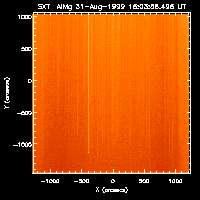 All manner of evils are apparent in this image. A dark current image
such as this is created by taking a picture without actually opening
the camera shutter. This allows the dark current to accumulate as it
normally would, but since there's no light on the CCD we're able to
use this measurement to remove the dark current from the actual data.
There are a number of features present in this image: Note the
increase in intensity from bottom to top, and also notice the
streaks due to hot
pixels -- defects in the CCD that just won't stop leaking charge.
All manner of evils are apparent in this image. A dark current image
such as this is created by taking a picture without actually opening
the camera shutter. This allows the dark current to accumulate as it
normally would, but since there's no light on the CCD we're able to
use this measurement to remove the dark current from the actual data.
There are a number of features present in this image: Note the
increase in intensity from bottom to top, and also notice the
streaks due to hot
pixels -- defects in the CCD that just won't stop leaking charge.
- The images are corrected for stray light.
Some unwanted light, called stray light, gets into the telescope.
SXT images are subject to a certain amount of stray light.
It gets in because, over the years Yohkoh has been on orbit,
micrometeorites have poked tiny holes (pinholes)
in the thin filters (like aluminum foil)
used to let X-rays into the telescope.
The level
and nature of the stray light is dependent on the filters used for a
particular image. The Al.1 images (the ones used for this
demonstration) are particularly sensitive to stray light due to a
number of pinholes in the thin aluminum entrance filters. How bad is
this stray light? Well, the raw images we noted above provide a good
clue to how bad things are. Here's the stray light image:
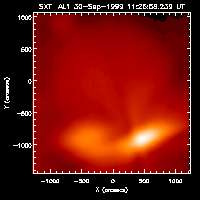 The fuzzy bright blobs near the bottom and to the right
of this image are clearly evident.
What's not evident is at least one similar blob near the top
left. The relative brightness of these blovs varies
depending on the pointing of the telescope.
(E.g., if we move
the sun up and left in this image, these bright spots will largely
disappear but others will pop up.)
The fuzzy bright blobs near the bottom and to the right
of this image are clearly evident.
What's not evident is at least one similar blob near the top
left. The relative brightness of these blovs varies
depending on the pointing of the telescope.
(E.g., if we move
the sun up and left in this image, these bright spots will largely
disappear but others will pop up.)
The stray light images are commonly referred to as terminator images.
This is because of the manner in which we collect them: as Yohkoh
orbits the earth, it passes in an out of spacecraft night, which is when
the earth is blocking the sun. When Yohkoh just emerges from behind
the earth, the sun's visible rays can reach the detector but the sun's X-rays
are blocked by the Earth's atmosphere. This happens to be a perfect time to
measure the level of visible stray light in the telescope.
- The images are co-registered, and scaled in intensity.
In this step, we correct the signal from the CCD for exposure time,
putting the long and short
exposures shown above on the same intensity scale as well as possible.
This is
done to prepare for making a combined image, which takes advantage of
the good parts of each image, and throws away the bad (overexposed or
underexposed) parts.
- The overexposed portions of the long-exposure image are
replaced with the short-exposure image to increase the overall dynamic
range.
Remember how parts of the bright image were saturated and causing CCD bleed?
Well, if we compare those parts of that image to the low-exposure image, we
find that there is detail clearly evident in the low-exposure image. By
virtue of software and ingenuity, if we replace the saturated parts with the
other image we get the final product:
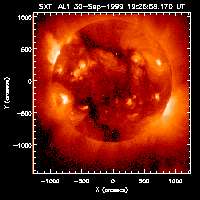
- The final product is posted to the
web.
Clearly, many steps take place between the raw data and the final product.
We've glossed over many details of this operation here, and the opportunity
for error looms over the entire process. Chief Observers are continually
vigilant, trying to keep the systems of correction in check.
In memoriam, Kiki Hudson (1941-1999).
Brian Handy <handy@physics.montana.edu>
Phil Shirts <shirts@lmsal.com>
October 1, 1999






